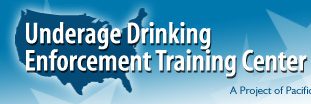Resource Materials
(See resource lists in Training Center documents for more resource materials.)
Limitations on Access to Alcohol:
Enforcing the underage drinking laws program: A compendium of resources, Office of Juvenile Justice and Delinquency Prevention (OJJDP), 1999.
Available from: National Criminal Justice Reference Service (NCJRS)
Online version: http://ojjdp.ncjrs.org/pubs/compendium99/contents.html
Keeping alcohol away from underage youth: Policy solutions. L. Pratt, C. Rothstein, J. Meath, & T. Toomey, 1997.
Available from: University of Minnesota Alcohol Epidemiology Program Online version: http://epihub.epi.umn.edu/alcohol/POLICY.HTML
Expressions of Community Norms:
Model ordinance for regulating billboard and other forms of outdoor alcohol advertising, J. F. Mosher & T. A. Shook, 1998.
Availability: Marin Institute, http://www.marininstitute.org/
Teen drinking prevention program: Communicator’s guide. Center for Substance Abuse Prevention, 1995.
Available: National Clearinghouse for Alcohol and Drug Information (NCADI), 1-800-729-6686, www.health.org
School-based Strategies:
Media skills as a substance abuse prevention strategy: A teacher’s supplement, Weekly Reader Corporation and Department of Health and Human Services, n.d.
Online: http://www.health.org/medltnew/wklyrd/index.htm
Setting and improving policies for reducing alcohol and other drug problems on campus: A guide for school administrators, W. DeJong, & S., Langenbahn, n.d.
Available: Higher Education Center for Alcohol and Other Drug Prevention
Available online: http://www.edc.org/hec/
Prevention of Impaired Driving:
Strategies for success: Combating juvenile DUI, NHTSA & OJJDP, 1999.
Available: OJJDP Clearinghouse, 1-800-638-8736
Summary on line: http://www.ncjrs.org/txtfiles1/fs99114.txt
Youth DWI and underage enforcement, National Highway Traffic Safety Administration (NHTSA), 1997.
Available: NHTSA, www.nhtsa.dot.gov, 1 800-424-9393
Selected Research
(See Training Center document, Strategies to Reduce Underage Alcohol Use for a more comprehensive list of related research.)
Limitations on Access to Alcohol:
Lewis, R. K., Paine-Andrews, A., Fawcett, S. B., Francisco, V. T., Richter, K. P., Copple, B., & Copple, J. E. (1996). Evaluating the effects of a community coalition’s efforts to reduce illegal sales of alcohol and tobacco products to minors. Journal of Community Health, 21(6), 429B436.
Preusser, D. F., Williams, A. F., & Weinstein, H. B. (1994). Policing underage alcohol sales. Journal of Safety Research, 25(3), 127B133.
Expressions of Community Norms:
Grube, J. W., & Wallack, L. (1994). Television beer advertising and drinking knowledge, beliefs, and intentions among schoolchildren. American Journal of Public Health, 84(2), 254-259.
Jernigan, D. H., & Wright, P. A. (1996). Media advocacy: Lessons from community experiences. Journal of Public Health Policy, 17(3), 306-329.
School based Strategies:
Moskowitz, J. M., & Jones, R. (1988). Alcohol and drug problems in the schools: Results of a national survey of school administrators. Journal of Studies on Alcohol, 49(4), 299B305.
Slater, M. D., Rouner, D., Murphy, K., Beauvais, F., Van Leuven, J., & Domenech-Rodriguez, M. M. (1996). Adolescent counterarguing of TV beer advertisements: Evidence for effectiveness of alcohol education and critical viewing discussions. Journal of Drug Education, 26(2), 143B158.
Impaired Driving Prevention:
Blomberg, R. D. (1993). Lower BAC limits for youth: Evaluation of the Maryland .02 law. In Alcohol and other drugs: Their role in transportation (Transportation Research Circular No. 413, pp. 25B27). Washington, DC: Transportation Research Board.
Ross, H. L. (1992). The deterrent capability of sobriety checkpoints: Summary of American literature. Washington, DC: NHTSA.
